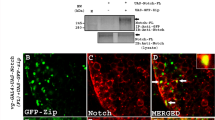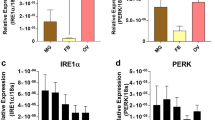Abstract
The RNA-binding protein Lark has an essential maternal role during Drosophila oogenesis. Elimination of maternal expression results in defects in cytoplasmic dumping and actin cytoskeletal organization in nurse cells. The function of this protein is dependent on the activity of one or more N-terminal RNA-binding domains. Here, we report the identification of Dmoesin (Dmoe) as a candidate RNA target of Lark during oogenesis. In addition to actin defects in the nurse cells of lark mutant ovaries, we observed mislocalization of posteriorly localized mRNAs including oskar and germ cell less in the developing oocyte. Anteriorly and dorsally localized mRNAs were not affected. In addition, we observed displacement of the actin cytoskeleton from the oocyte plasma membrane. These phenotypes are reminiscent of mutations in Dmoe and suggested that this RNA maybe a potential target of Lark. We observed a significant decrease in Dmoe protein associated with the membrane of the developing oocyte with no changes in expression or localization within the nurse cells. Evidence for an association between Lark protein and moe RNA during oogenesis comes from results of a microarray-based Ribonomics approach to identify Lark RNA targets. Thus, our results provide evidence that Dmoe RNA is a target of Lark during oogenesis and that it likely regulates either the splicing or translation of this RNA.






Similar content being viewed by others
References
Babu K, Cai Y, Bahri S, Yang X, Chia W (2004) Roles of Bifocal, Homer, and F-actin in anchoring Oskar to the posterior cortex of Drosophila oocytes. Genes Dev 18:138–143
Bohrmann J, Biber K (1994) Cytoskeleton-dependent transport of cytoplasmic in previtellogenic to mid-vitellogenic ovarian follicles of Drosophila: time-lapse analysis using video-enhanced contrast microscopy. J Cell Sci 107(Pt 4):849–858
Chou TB, Perrimon N (1996) The autosomal FLP-DFS technique for generating germline mosaics in Drosophila melanogaster. Genetics 144:1673–1679
de Cuevas M, Lilly MA, Spradling AC (1997) Germline cyst formation in Drosophila. Annu Rev Genet 31:405–428
Dreyfuss G, Kim VN, Kataoka N (2002) Messenger-RNA-binding proteins and the messages they carry. Nat Rev Mol Cell Biol 3:195–205
Edwards KA, Kiehart DP (1996) Drosophila nonmuscle myosin II has multiple essential roles in imaginal disc and egg chamber morphogenesis. Development 122:1499–1511
Edwards KA, Demsky M, Montague RA, Weymouth N, Kiehart DP (1997) GFP-moesin illuminates actin cytoskeleton dynamics in living tissue and demonstrates cell shape changes during morphogenesis in Drosophila. Dev Biol 191:103–117
Glotzer JB, Saffrich R, Glotzer M, Ephrussi A (1997) Cytoplasmic flows localize injected oskar RNA in Drosophila oocytes. Curr Biol 7:326–337
Guild GM, Connelly PS, Shaw MK, Tilney LG (1997) Actin filament cables in Drosophila nurse cells are composed of modules that slide passively past one another during dumping. J Cell Biol 138:783–797
Gutzeit HO (1986) The role of microfilaments in cytoplasmic streaming in Drosophila follicles. J Cell Sci 80:159–169
Gutzeit HO, and Huebner E (1986b) Comparison of microfilament patterns in nurse cells of different insects with polytrophic and telotrophic ovarioles. J Embryol Exp Morphol 93:291–301
Hachet O, Ephrussi A (2001) Drosophila Y14 shuttles to the posterior of the oocyte and is required for oskar mRNA transport. Curr Biol 11:1666–1674
Hastings ML, Krainer AR (2001) Pre-mRNA splicing in the new millennium. Curr Opin Cell Biol 13:302–309
Huang Y, Genova G, Roberts M, Jackson FR (2007) The LARK RNA-binding protein selectively regulates the Circadian eclosion rhythm by controlling E74 protein expression. PLoS ONE 2:e1107
Huynh JR, Munro TP, Smith-Litiere K, Lepesant JA, St Johnston D (2004) The Drosophila hnRNPA/B homolog, Hrp48, is specifically required for a distinct step in osk mRNA localization. Dev Cell 6:625–635
Jackson FR, Genova GK, Huang Y, Kleyner Y, Suh J, Roberts MA, Sundram V, Akten B (2005) Genetic and biochemical strategies for identifying Drosophila genes that function in circadian control. Methods Enzymol 393:663–682
Jankovics F, Sinka R, Lukacsovich T, Erdelyi M (2002) MOESIN crosslinks actin and cell membrane in Drosophila oocytes and is required for OSKAR anchoring. Curr Biol 12:2060–2065
Jongens TA, Hay B, Jan LY, Jan YN (1992) The germ cell-less gene product: a posteriorly localized component necessary for germ cell development in Drosophila. Cell 70:569–584
Kim-Ha J, Smith JL, Macdonald PM (1991) oskar mRNA is localized to the posterior pole of the Drosophila oocyte. Cell 66:23–35
Lai MC, Kuo HW, Chang WC, Tarn WY (2003) A novel splicing regulator shares a nuclear import pathway with SR proteins. EMBO J 22:1359–1369
Mahajan-Miklos S, Cooley L (1994) Intercellular cytoplasm transport during Drosophila oogenesis. Dev Biol 165:336–351
Markus MA, Morris BJ (2006) Lark is the splicing factor RBM4 and exhibits unique subnuclear localization properties. DNA Cell Biol 25:457–464
McNeil GP, Zhang X, Genova G, Jackson FR (1998) A molecular rhythm mediating circadian clock output in Drosophila. Neuron 20:297–303
McNeil GP, Zhang X, Roberts M, Jackson FR (1999) Maternal function of a retroviral-type zinc-finger protein is essential for Drosophila development. Dev Genet 25:387–396
McNeil GP, Smith F, Galioto R (2004) The Drosophila RNA-binding protein Lark is required for the organization of the actin cytoskeleton and Hu-li tai shao localization during oogenesis. Genesis 40:90–100
Mohr SE, Dillon ST, Boswell RE (2001) The RNA-binding protein Tsunagi interacts with Mago Nashi to establish polarity and localize oskar mRNA during Drosophila oogenesis. Genes Dev 15:2886–2899
Newby LM, Jackson FR (1993) A new biological rhythm mutant of Drosophila melanogaster that identifies a gene with an essential embryonic function. Genetics 135:1077–1090
Newby LM, White L, DiBartolomeis SM, Walker BJ, Dowse HB, Ringo JM, Khuda N, Jackson FR (1991) Mutational analysis of the Drosophila miniature-dusky (m-dy) locus: effects on cell size and circadian rhythms. Genetics 128:571–582
Newmark PA, Boswell RE (1994) The mago nashi locus encodes an essential product required for germ plasm assembly in Drosophila. Development 120:1303–1313
Palacios IM, Gatfield D, St Johnston D, Izaurralde E (2004) An eIF4AIII-containing complex required for mRNA localization and nonsense-mediated mRNA decay. Nature 427:753–757
Polesello C, Delon I, Valenti P, Ferrer P, Payre F (2002) Dmoesin controls actin-based cell shape and polarity during Drosophila melanogaster oogenesis. Nat Cell Biol 4:782–789
Riechmann V, Ephrussi A (2001) Axis formation during Drosophila oogenesis. Curr Opin Genet Dev 11:374–383
Riparbelli MG, Callaini G (1995) Cytoskeleton of the Drosophila egg chamber: new observations on microfilament distribution during oocyte growth. Cell Motil Cytoskelet 31:298–306
Robinson DN, Smith-Leiker TA, Sokol NS, Hudson AM, Cooley L (1997) Formation of the Drosophila ovarian ring canal inner rim depends on cheerio. Genetics 145:1063–1072
Saxton WM (2001) Microtubules, motors, and mRNA localization mechanisms: watching fluorescent messages move. Cell 107:707–710
Schroeder AJ, Genova GK, Roberts MA, Kleyner Y, Suh J, Jackson FR (2003) Cell-specific expression of the lark RNA-binding protein in Drosophila results in morphological and circadian behavioral phenotypes. J Neurogenet 17:139–169
Speck O, Hughes SC, Noren NK, Kulikauskas RM, Fehon RG (2003) Moesin functions antagonistically to the Rho pathway to maintain epithelial integrity. Nature 421:83–87
Spradling A (1993) Developmental genetics of oogenesis. In: Martinez-Arias BA (ed) The development of Drosophila melanogaster. Cold Spring Harbor, New York, pp 1–70
St Johnston D (1995) The intracellular localization of messenger RNAs. Cell 81:161–170
St Johnston D, Beuchle D, Nusslein-Volhard C (1991) Staufen, a gene required to localize maternal RNAs in the Drosophila egg. Cell 66:51–63
Tenenbaum SA, Lager PJ, Carson CC, Keene JD (2002) Ribonomics: identifying mRNA subsets in mRNP complexes using antibodies to RNA-binding proteins and genomic arrays. Methods 26:191–198
Theurkauf WE, Smiley S, Wong ML, Alberts BM (1992) Reorganization of the cytoskeleton during Drosophila oogenesis: implications for axis specification and intercellular transport. Development 115:923–936
Theurkauf WE, Alberts BM, Jan YN, Jongens TA (1993) A central role for microtubules in the differentiation of Drosophila oocytes. Development 118:1169–1180
van Eeden FJ, Palacios IM, Petronczki M, Weston MJ, St Johnston D (2001) Barentsz is essential for the posterior localization of oskar mRNA and colocalizes with it to the posterior pole. J Cell Biol 154:511–523
Wheatley S, Kulkarni S, Karess R (1995) Drosophila nonmuscle myosin II is required for rapid cytoplasmic transport during oogenesis and for axial nuclear migration in early embryos. Development 121:1937–1946
Wilhelm JE, Mansfield J, Hom-Booher N, Wang S, Turck CW, Hazelrigg T, Vale RD (2000) Isolation of a ribonucleoprotein complex involved in mRNA localization in Drosophila oocytes. J Cell Biol 148:427–440
Acknowledgements
We are grateful to F. Rob Jackson and his lab, especially Mary Roberts, Yanmei Huang, and Ginka Genova for fly stocks, reagents, and unpublished methodologies related to these studies. We thank Dr. Paul MacDonald for providing us with the bcd cDNA clone and Dan Kiehart for the anti-moe antibody. We would also like to thank Wenxiang Zhang and Connie Zhao of The Rockefeller University Genomics Resource Center for microarray analysis and Xuning Wang of the Rockefeller University IT Department for analysis of the microarray data. This work was supported by grants from the NIH and PSC-CUNY to G.P.M.
Author information
Authors and Affiliations
Corresponding author
Additional information
Communicated by C. Desplan
Electronic supplementary material
Below is the link to the Electronic supplementary material.
Supplemental Table 1
The 37 candidate Lark targets that showed a fold enrichment of 1.4 or greater over Total RNA in three independent immunoprecipitation experiments (DOC 72.5 KB)
Rights and permissions
About this article
Cite this article
McNeil, G.P., Kaur, M., Purrier, S. et al. The Drosophila RNA-binding protein Lark is required for localization of Dmoesin to the oocyte cortex during oogenesis. Dev Genes Evol 219, 11–19 (2009). https://doi.org/10.1007/s00427-008-0260-x
Received:
Accepted:
Published:
Issue Date:
DOI: https://doi.org/10.1007/s00427-008-0260-x




